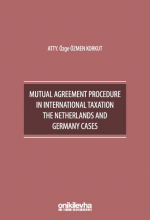 The mutual agreement procedure, which provides a solution to the double taxation issues encountered in the field of international taxation, is analyzed in this book through the examples of the Netherlands and Germany. The author analyzes the legal framework, implementation processes and effectiveness of the mutual agreement procedure, with a special emphasis on Turkey's tax treaties with these two important trading partners.
The book is a guide to the complex world of international tax law. It is a valuable resource for lawyers, academics, tax experts, international businesses and policy makers, and contributes to a fairer and more efficient system of international taxation by providing recommendations to improve the effectiveness of the reciprocal treaty procedure.(ARKA KAPAKTAN)
The mutual agreement procedure, which provides a solution to the double taxation issues encountered in the field of international taxation, is analyzed in this book through the examples of the Netherlands and Germany. The author analyzes the legal framework, implementation processes and effectiveness of the mutual agreement procedure, with a special emphasis on Turkey's tax treaties with these two important trading partners.
The book is a guide to the complex world of international tax law. It is a valuable resource for lawyers, academics, tax experts, international businesses and policy makers, and contributes to a fairer and more efficient system of international taxation by providing recommendations to improve the effectiveness of the reciprocal treaty procedure.(ARKA KAPAKTAN)
TABLE OF CONTENTS
CHAPTER 1
INTRODUCTION
CHAPTER 2
FUNDAMENTAL PRINCIPLES OF INTERNATIONAL TAXATION AND TAX TREATIES
2.1. The Relationship Between Tax Law and International Law
2.2. International Taxation
2.2.1. Source Principle
2.2.2. Residence Principle
2.2.3. Nationality Principle
2.2.4. The Approach of Turkish Tax Legislation to the Subject
2.3. International Tax Treaties
2.3.1. Conclusion of International Agreements
2.3.2. Termination of International Agreements
2.4. Double Taxation Avoidance Agreements
2.4.1. The Concept of Double Taxation
2.4.2. National Regulations on Preventing Double Taxation
2.5. International Agreement Models
2.5.1. The Concept of Model Agreement
2.5.2. OECD Model
2.5.3. UN Model
2.5.4. Turkish Model
2.5.5. Bilateral Tax Treaties
2.5.6. Regulations on the Mutual Agreement Procedure in Turkish Domestic Law
CHAPTER 3
MUTUAL AGREEMENT PROCEDURE
3.1. Enhancing the Effectiveness of the Mutual Agreement Procedure
3.1.1. In General
3.1.2. BEPS Action Plan 14 and 15
3.2. Application of the Mutual Agreement Procedure
3.2.1. In General
3.2.2. Application Procedure
3.2.3. Application Period
3.3. Mutual Agreement Procedure and Litigation
3.3.1. In General
3.3.2. The Impact of Applying for the Mutual Agreement Procedure on Litigation
3.1. Finalization of the Mutual Agreement Procedure Application
3.3.3. In General
3.3.4. Finalization of the Mutual Agreement Procedure Application According to Tax Model Agreements
3.3.5. Finalization of the Mutual Agreement Procedure Application According to Bilateral Tax Treaties
3.3.6. Finalization of the Mutual Agreement Procedure Application According to the Provisions of the Tax Procedure Law
3.1. Lawsuits Filed and Requests for Conciliation Before Applying for the Mutual Agreement Procedure
3.3.7. Lawsuits Filed and Requests for Conciliation Before Applying According to Tax Model Agreements
3.3.8. Lawsuits Filed and Requests for Conciliation Before Applying According to Bilateral Tax Treaties
3.3.9. Lawsuits Filed and Requests for Conciliation Before Applying According to the Provisions of the Tax Procedure Law
3.4. Other Issues Related to the Mutual Agreement Procedure
3.4.1. In General
3.4.2. Other Issues According to Tax Model Agreements
3.4.3. International Statistics on the Mutual Agreement Procedure
3.4.4. Other Issues According to Bilateral Tax Treaties
3.4.5. Other Issues According to the Provisions of the Tax Procedure Law
3.4.6. Comparison of the Mutual Agreement Procedure and Conciliation in the Tax Procedure Law
3.4.7. Criticisms of the Mutual Agreement Procedure
3.5. Corresponding Adjustments
3.6. Arbitration in the Mutual Agreement Procedure
3.6.1. In General
3.6.2. Arbitration According to Tax Treaties
3.6.3. Arbitration in Terms of Turkish Legislation
CHAPTER 4
CONCLUSION
REFERENCES
